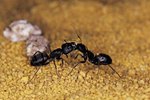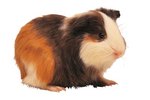
Your birds -- whether caged feathered pets or backyard poultry -- are susceptible to mite and lice infestation. While you can buy over-the-counter sprays to treat your pest problem, it's crucial to make sure that whatever you're using is designed for avian species. If you suspect mites or lice are present on your friend or flock, have your veterinarian conduct a skin scraping to confirm their presence and recommend a suitable insecticide.
Mite and Lice Infestation
Many bird mites are too small to see with the naked eye. Lice are larger, and their eggs can be seen stuck to the base of feathers. Parakeets might suffer from scaly face mange mites that affect their beaks, nose and legs. These mites leave a powdery residue in these areas. Birds with large numbers of mites or lice scratch and look unkempt. While most mites and lice are avian-specific, there are some that will bite people. If you start scratching and develop welts for no apparent reason, take a good look at your bird.
Permethrin and Pyrethrin Sprays
It's likely your veterinarian will recommend a mite and lice spray for your bird containing either permethrins or pyrethrins. The former is a synthetic form of the latter. Pyrethrins have been used for centuries as an insecticide. Specific chrysanthemum species contain natural bug-killing compounds known as pyrethrums. You can't just pulverize chrysanthemums from your garden and spray the residue on your bird -- domestic chrysanthemums don't contain the compound. These relatively safe products work by affecting the nervous systems of mites and lice, paralyzing and eventually killing them. Pyrethrins are effective at killing the Dermanyssus gallinae mite in parakeets, according to the California Department of Pesticide Regulation website.
Spraying Caged Birds
When using a mite and lice spray on your caged bird, follow the product's directions carefully. Avoid spraying the insecticide in your bird's eyes. In addition to spraying your pet, you should also thoroughly spray the cage. Take out the food bowls and water bottles beforehand, hand-washing them in mild soap and hot water. Remove any bedding in nest boxes or elsewhere in the cage before spraying. Because mites lay eggs in hard-to-reach places, make sure to spray every inch of the cage, inside and outside. Remove the bird during the spraying process.
Insectides for Poultry
If you've got mite-ridden and lousy poultry, you might want to use another type of insecticide. Sprays containing carbaryl (1-Naphthyl-N-methylcarbamate) are used to rid poultry -- including chickens, geese, ducks, turkeys, pigeons and game species -- of lice, mice and fleas. Don't use this product on any birds intended for slaughter within a week after the application. The entire process of spraying the birds, roosts, cages and building must be repeated one month later to eradicate all pests.
Other Treatment Options
Besides sprays, you can find insecticides designed for birds in powder form. Dusting a large area such as a chicken coop might be easier than spraying. Your vet might treat your pet bird with the dewormer ivermectin, which also gets rid of mites and lice.
References
- Avianweb: Feather Lice
- University of Kentucky: External Mite and Insect Parasites of Backyard Chickens
- The Lake Veterinary Hospitals: Avitrol Bird Mite and Lice Spray
- Exotic Pet Vet: Of Mites and Men
- AllPro: Carbaryl 80S
- California Department of Pesticide Regulation: Environmental Fate of Pyrethrins
- Mississippi State University Extension: Bug-Wise
Photo Credits
-
Photodisc/Photodisc/Getty Images
Writer Bio
Jane Meggitt has been a writer for more than 20 years. In addition to reporting for a major newspaper chain, she has been published in "Horse News," "Suburban Classic," "Hoof Beats," "Equine Journal" and other publications. She has a Bachelor of Arts in English from New York University and an Associate of Arts from the American Academy of Dramatics Arts, New York City.




